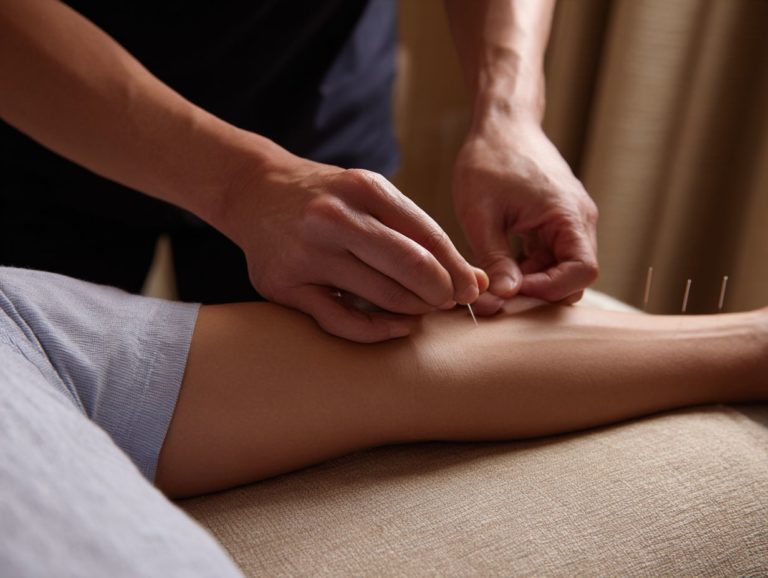Acupuncture and Endorphin Release: Pain Relief
Acupuncture effectively stimulates the release of endorphins, which act as natural pain relievers. By stimulating opioid receptors, acupuncture-along with techniques like electroacupuncture-offers a safe alternative to traditional pain relief methods, including opioid medications like heroin. This article explores how this old practice can improve your health by using brain chemicals to manage pain effectively. Learn about the science involved and the advantages it offers.
Key Takeaways:
- Acupuncture is a traditional Chinese medicine technique that stimulates specific points on the body to promote natural healing and alleviate pain.
- Endorphins, the body’s natural painkillers, are released during acupuncture, providing significant relief for various types of pain, including chronic and acute conditions.
- Research supports acupuncture’s effectiveness in boosting endorphin levels, making it a viable alternative for pain management compared to conventional methods.
Contents
- 1 Understanding Pain and Endorphins
- 2 The Mechanism of Acupuncture
- 3 Research and Evidence
- 4 Benefits of Acupuncture for Pain Management
- 5 Acupuncture Pain Relief Statistics
- 5.1 Acupuncture Effectiveness on Chronic Pain: Comparison of Acupuncture vs. Control
- 5.2 Acupuncture Effectiveness on Chronic Pain: Patient Statistics
- 5.3 Pain Relief Reporting: Response Rate by Treatment Type
- 5.4 Pain Relief Reporting: Common Indications for Acupuncture
- 5.5 Chronic Pain Conditions
- 5.6 Acute Pain Relief
- 5.7 Comparison with Other Pain Relief Methods
- 6 Risks and Considerations
- 7 Frequently Asked Questions
- 7.1 What is the relationship between acupuncture and endorphin release for pain relief?
- 7.2 How does acupuncture promote endorphin release?
- 7.3 Can acupuncture effectively manage pain through endorphin release?
- 7.4 How long does the effect of endorphin release from acupuncture last?
- 7.5 Are there specific types of pain that acupuncture and endorphin release can help relieve?
- 7.6 Is acupuncture safe for enhancing endorphin release and pain relief?
Definition and History

Acupuncture is defined as the insertion of needles into specific points on the body to promote healing, with written records dating back to 100 BCE in China.
Throughout history, acupuncture has evolved significantly. During the Tang Dynasty (618-907 CE), methods and ideas were improved, resulting in the detailed writings we study today.
A notable landmark was in the 1970s when President Richard M. Nixon visited China and observed acupuncture as a medical practice. This experience increased interest in acupuncture in the United States, leading to more research and training programs, which helped it become more accepted in Western medicine. According to a detailed overview by News Medical, this period marked a significant turning point for acupuncture’s integration into Western healthcare. Today, acupuncture is recognized as a complementary treatment for various conditions, from chronic pain to stress relief. For those seeking alternatives to traditional pain management, understanding how acupuncture can provide relief is essential, as outlined in our [guide on Opioid Alternatives: Acupuncture for Chronic Pain Relief](https://sereneclinics.com/holistic-health/traditional-medicine-systems/traditional-chinese-medicine/acupuncture/acupuncture-for-pain-relief/acupuncture-chronic-pain-relief/).
Principles of Traditional Chinese Medicine
Traditional Chinese Medicine (TCM) is based on the principles of balance, including the interplay of yin and yang and the flow of qi (energy) through the body.
In TCM, health is viewed as a harmonious flow of qi through meridians, which are channels connecting various body parts. Acupuncture seeks to restore this flow by targeting specific points along these meridians, effectively addressing blockages or imbalances. For an extensive analysis of how acupuncture integrates with other medical practices, our comprehensive overview of acupuncture and Western medicine examines the benefits and applications.
For example, to alleviate chronic pain, practitioners might stimulate points on the liver or kidney meridians.
Herbs are useful; for instance, Bai Zhu can increase energy, and Ginger can help warm the body to lessen cold symptoms. This method focuses on bringing back balance instead of only addressing the symptoms.
Understanding Pain and Endorphins
Knowing how pain perception and endorphin release affect each other is important for assessing how well acupuncture works in managing pain. Recent research highlights the significant role of endorphins in pain modulation, as observed in studies published by ScienceDirect.
What are Endorphins?
Endorphins are endogenous peptides produced by the body, acting on opioid receptors to reduce pain and induce feelings of euphoria.
There are different kinds of endorphins, such as enkephalins, which help control pain by regulating how pain signals are sent through the nervous system.
Dynorphins, on the other hand, are associated with stress responses and can impact mood and addiction.
To increase endorphin levels naturally, try activities such as:
- Regular physical activity
- Mindfulness meditation
- Activities that spark laughter-like watching a funny movie
Dietary choices such as dark chocolate and spicy foods can also stimulate endorphin release, contributing to an overall sense of well-being.
The Role of Endorphins in Pain Relief
Endorphins help reduce pain by attaching to opioid receptors, which affects how pain signals are processed in the brain and spinal cord.
In treatments such as acupuncture, this process is used to improve pain relief. Acupuncture stimulates specific points in the body, which can lead to increased endorphin release.
For instance, a study found that patients receiving acupuncture for knee pain reported a significant reduction in discomfort. Practitioners often use tools such as fine needles and electrical stimulation at acupuncture points like LI4 and ST36, known for their analgesic effects.
This focused method helps reduce pain and improves overall well-being by lifting mood and lowering stress.
Types of Pain Treated by Acupuncture
Acupuncture has shown efficacy in treating various pain types, including chronic conditions like arthritis and acute pain from injuries.
Conditions effectively treated with acupuncture encompass migraine headaches, lower back pain, and fibromyalgia. A recent article from the American Academy of Family Physicians highlights research demonstrating significant relief from chronic lower back pain with acupuncture, resulting in improved mobility and reduced dependence on pain medications. This method aligns with the principles outlined in our analysis of opioid alternatives: acupuncture for chronic pain relief.
In combination therapies, acupuncture enhances outcomes alongside physical therapy, particularly for post-surgical pain management.
Combining these methods can lead to quicker recovery and greater patient satisfaction, making acupuncture a practical option in pain management plans.
The Mechanism of Acupuncture
The mechanism of acupuncture involves complex interactions within the brain and body, impacting neurochemical pathways and signaling processes.
How Acupuncture Works
Acupuncture works by stimulating specific points, which activates sensory fibers and elicits a neurochemical response that promotes healing.
This neurochemical response involves the release of endorphins, which act as natural pain relievers.
For instance, a needle placed in the LI4 point, located between the thumb and index finger, can relieve headaches by influencing areas of the brain responsible for pain perception.
The ST36 point, located just below the knee, can improve immune function and increase energy.
Practitioners usually choose points based on the patient’s symptoms, using a focused method that may include overall evaluations or specific tests like the pulse check from Traditional Chinese Medicine.
Activation of Endorphin Release

The activation of endorphin release during acupuncture involves specific stimulation techniques, including frequency-dependent electrical stimulation.
Electroacupuncture, which combines traditional acupuncture with electrical stimulation, acts by enhancing the analgesic effects of endorphins.
Practitioners typically apply small electric currents to the acupuncture needles, often set at low frequencies (2-10 Hz) to target pain relief.
Research shows that this method can significantly increase beta-endorphin levels, providing longer-lasting pain relief compared to manual acupuncture alone.
Using a TENS (Transcutaneous Electrical Nerve Stimulation) unit can increase these effects by activating nerve endings more, resulting in a greater response from the body’s natural pain relief systems.
Research and Evidence
Research shows that acupuncture can effectively relieve pain, and many clinical trials have confirmed its benefits.
Clinical Studies on Acupuncture and Pain Relief
Multiple clinical studies demonstrate significant outcomes, with over 70% of participants reporting reduced pain levels after acupuncture treatment.
For instance, a 2019 meta-analysis reviewed 39 trials involving over 3,000 patients, highlighting that acupuncture had a marked effect on the treatment of chronic pain conditions such as back pain and arthritis.
The studies employed randomized controlled trial methodologies, with participants receiving either real or sham acupuncture. Results showed that patients receiving authentic acupuncture reported a 40% improvement in pain relief compared to those in the control groups.
These careful methods and good results show that acupuncture is a reliable treatment choice.
Endorphin Levels and Acupuncture
Research shows that acupuncture reduces pain and raises endorphin levels in patients after treatment.
Studies have shown that patients receiving acupuncture experienced a 20-40% increase in endorphin levels within 30 minutes of treatment.
For instance, a study published in the Journal of Pain Research recorded elevated endorphin levels after sessions focused on chronic pain management.
Using acupuncture together with physical therapy can improve results; patients frequently say they feel better relief from pain, particularly for issues like arthritis or lower back pain.
Using acupuncture in a complete treatment plan can be an effective method for managing pain.
Benefits of Acupuncture for Pain Management
Acupuncture provides many advantages for managing pain, such as less need for medication and better health results. In fact, many seek out opioid alternatives like acupuncture for chronic pain relief.
Acupuncture Pain Relief Statistics
Acupuncture Pain Relief Statistics
Acupuncture Effectiveness on Chronic Pain: Comparison of Acupuncture vs. Control
Acupuncture Effectiveness on Chronic Pain: Patient Statistics
Pain Relief Reporting: Response Rate by Treatment Type

Pain Relief Reporting: Common Indications for Acupuncture
The Acupuncture Pain Relief Statistics give a clear summary of how well acupuncture works for chronic pain, backed by patient information and treatment results. The results highlight that acupuncture can serve as a practical option or addition to traditional methods for managing pain.
In the Acupuncture Effectiveness on Chronic Pain The comparison between the acupuncture group and the control group shows important findings. The effect size of acupuncture compared to no acupuncture control is 0.55, indicating a moderate to large effect. This suggests that acupuncture can effectively reduce pain more than not receiving treatment at all. When comparing acupuncture to sham acupuncture, which is a fake treatment, the effect size is 0.37, indicating that while acupuncture is more effective than a sham treatment, the difference is not as pronounced as compared to no treatment.
- Patient Statistics: The study analyzed a total of 17,922 patients, with 14,697 patients receiving actual acupuncture and 5,230 receiving sham acupuncture. This large sample size lends credibility to the findings, reinforcing the statistical significance of the observed effects.
In another dataset focusing on Pain Relief Reporting, the response rates to different treatments show that 50% of patients receiving acupuncture reported pain relief, compared to 42.5% for those receiving sham acupuncture and 30% for the no acupuncture control group. This data shows that acupuncture is more effective than a placebo and offers significant relief compared to patients who did not receive treatment.
Furthermore, the common indications for acupuncture include conditions like low back pain, headaches, osteoarthritis, and shoulder pain. Each of these conditions is prevalent in various populations, and the consistent reporting of effectiveness across these pain types suggests that acupuncture may be broadly applicable as a pain management option.
Overall, the Acupuncture Pain Relief Statistics Show that acupuncture effectively treats chronic pain, backed by strong data on patient results and response rates. As more people look for different ways to manage pain, these findings highlight the benefits of acupuncture and its part in combined healthcare methods.
Chronic Pain Conditions
For chronic pain conditions such as fibromyalgia and lower back pain, acupuncture has been shown to provide significant relief and improved quality of life.
Patients often report a reduction in pain levels after just a few sessions.
For fibromyalgia, treatment typically involves a combination of points focusing on pain relief and muscle relaxation, administered twice a week.
Lower back pain may respond well to targeted acupuncture in the lumbar region, alongside broader treatment for muscle tension.
Success stories abound, with many patients experiencing up to a 50% decrease in pain, allowing them to return to activities they thought they’d have to give up permanently.
Acute Pain Relief
In cases of acute pain, such as post-operative discomfort or sports injuries, acupuncture can provide immediate relief and expedite recovery processes.
Practitioners often use techniques like needling at specific points such as LI4 and ST36, which are known to alleviate pain and promote healing.
For instance, a recent patient recovering from knee surgery reported significant relief after just two sessions, enabling quicker physical therapy participation.
Incorporating electro-acupuncture can heighten these effects by enhancing circulation and reducing inflammation.
Many professionals suggest a follow-up treatment within a week to maintain results, focusing on each person’s needs and healing responses.
Comparison with Other Pain Relief Methods
Compared to conventional pain relief methods, acupuncture presents a non-invasive alternative that minimizes the risk of opioid dependence.
Acupuncture has shown effectiveness in treating various conditions, including chronic back pain, arthritis, and migraines. A study from the Annals of Internal Medicine found that acupuncture significantly reduced chronic pain in over 18,000 adults, emphasizing its potential as a preferred option for those wary of medication.
In contrast, traditional pain relief methods often involve NSAIDs or opioids, which can lead to side effects such as gastrointestinal issues or addiction. Therefore, while acupuncture may require more sessions to achieve results, its long-term benefits can outweigh the risks associated with pharmaceuticals.
Risks and Considerations
While acupuncture is generally safe, it is important to be aware of potential risks and considerations before undergoing treatment. Understanding the risks and side effects of acupuncture can help you make informed decisions about your health and well-being.
Possible Side Effects of Acupuncture
Common side effects of acupuncture can include minor bruising, soreness at insertion points, and, in rare cases, infections.
To reduce these risks, practitioners must use clean, disposable needles and follow proper hygiene procedures.
It’s also beneficial to choose a licensed acupuncturist with good reviews and experience. Patients can reduce discomfort by communicating openly about their pain tolerance and relaxation levels during the session.
Keeping hydrated before and after treatment can help mitigate soreness and promote healing. Eating a balanced diet and managing any allergies beforehand can improve the safety of your acupuncture session.
Who Should Avoid Acupuncture?
Certain individuals, such as those with bleeding disorders or pregnant women, may need to avoid acupuncture due to potential risks.
Other groups should also exercise caution before undergoing acupuncture. Those with compromised immune systems, such as individuals with HIV/AIDS or autoimmune diseases, might face increased infection risks.
Individuals with significant heart problems or those using blood-thinning medications should consult their doctors before beginning treatment. Make sure that the acupuncturist is licensed and follows safety rules to reduce risks.
Engaging in a thorough pre-session consultation can help assess individual health conditions and tailor the approach appropriately.
Final Thoughts on Acupuncture and Endorphins

The link between acupuncture and the release of endorphins shows important ways to improve pain relief methods.
Research indicates that acupuncture stimulates endorphin production, leading to natural pain relief. Practitioners can use needles at certain points, like St36 or LI4, which are known to promote the release of endorphins.
Using electroacupuncture can increase these benefits by providing a constant signal, which can help with relaxation and reduce pain.
Patients might also consider combining acupuncture with mindfulness practices, as this synergistic approach can support overall well-being while effectively managing chronic pain.
Future Research Directions
Future research on acupuncture could examine the most effective treatment approaches and evaluate its impact on various kinds of chronic pain.
Researchers should investigate specific factors such as needle depth, stimulation duration, and the frequency of treatments to identify the most effective approaches for conditions like fibromyalgia or osteoarthritis.
Meta-analyses combining data from diverse studies could reveal trends in efficacy across demographics. Exploring patient-specific factors-such as age, comorbidities, and psychological state-might also tailor acupuncture protocols for better outcomes.
This targeted approach can lead to more consistent pain management protocols, enhancing the integration of acupuncture into conventional treatment plans.
Key Studies and Articles
Key studies include those published by the National Institutes of Health highlighting the effectiveness of acupuncture in chronic pain management.
One notable study from 2017 found that acupuncture significantly reduced pain levels in participants with chronic back pain, showcasing its potential as a complementary treatment.
A significant study from 2018 showed that acupuncture might work better than standard medication for arthritis pain, indicating it could help patients live better lives.
The World Health Organization recognizes acupuncture for treating various conditions, further solidifying its credibility.
For those thinking about this therapy, talking to a licensed acupuncturist can improve treatment results by focusing on specific areas of pain.
Frequently Asked Questions
What is the relationship between acupuncture and endorphin release for pain relief?
Acupuncture involves the insertion of thin needles into specific points on the body, which can stimulate the release of endorphins. These natural pain-relieving chemicals help reduce the perception of pain and promote a sense of well-being, making acupuncture an effective method for pain relief.
How does acupuncture promote endorphin release?
During an acupuncture session, the needles trigger the body’s nervous system to release endorphins and other neurotransmitters. This process enhances the body’s natural pain relief mechanisms and can lead to significant reductions in discomfort for those suffering from chronic pain conditions.
Can acupuncture effectively manage pain through endorphin release?
Yes, acupuncture can effectively manage pain by promoting endorphin release. Many patients say they feel less pain and can move better after treatment, making it a good choice for those looking for different ways to relieve pain.
How long does the effect of endorphin release from acupuncture last?
The effects of endorphin release from acupuncture can vary among individuals. Typically, patients may experience pain relief lasting from several hours to a few days after treatment. Regular sessions may lead to more sustained benefits over time.
Are there specific types of pain that acupuncture and endorphin release can help relieve?
Acupuncture and endorphin release have been shown to be effective for various types of pain, including chronic back pain, migraines, arthritis, and fibromyalgia. Many individuals find that acupuncture provides relief for their specific pain conditions.
Is acupuncture safe for enhancing endorphin release and pain relief?
Yes, acupuncture is generally considered safe when performed by a trained and licensed practitioner. It has few side effects and can be a helpful addition to traditional pain relief methods, promoting the release of endorphins to improve pain management.

Sheetal Sharda has a background in CS. She got an interest in Holistic living back in 2018, and has since started exploring more into Naturapathy, Holistic Living, Yoga, and more. She got inspired to start SereneClinics to help people find reliable centers across the world.






